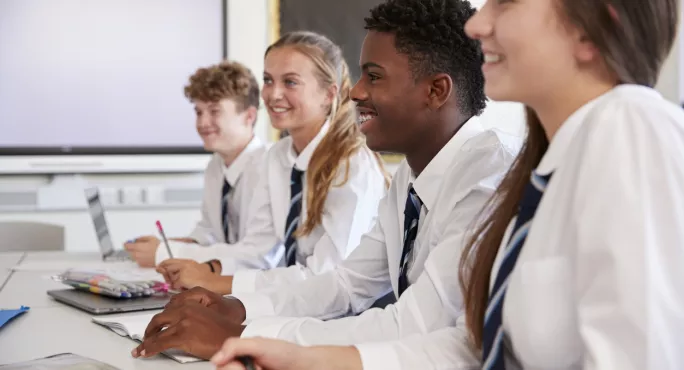
- Home
- Teaching & Learning
- Secondary
- How do you know when learning is truly happening?
How do you know when learning is truly happening?

In a recent poll of more than 7,700 teachers on Teacher Tapp, three-quarters agreed with this statement: “I don’t mind pupils chatting in my classroom, as long as they get the work done”.
The discussions which followed were interesting. Many of those who agreed assumed that those who didn’t agree had silent classrooms with no time for pupils to discuss their ideas or seek help from each other.
Personally, I’m a fan of dialogic teaching, which sees talk as central, and yet I disagreed with the statement. For me, the assumption about silent classrooms couldn’t be further from the truth: instead, the difference is in how we see talk in the classroom and in how we see the purpose of the work that pupils do.
More by Mark Enser:
Some of the 77 per cent who agreed with the statement argued that there was no reason to stop pupils chatting in the case, because as the caveat says, the work is done.
If the work gets done, they argue, there can’t be a problem with the chatter. However, I would suggest that there is a difference between work being done and learning occurring. This difference cuts to the heart of an issue in our education system.
Why being busy doesn’t translate to learning
It is perfectly possible to be very busy in the classroom and yet to learn very little. We can transfer information from place to place, highlight notes and make a mind map of all the things we already know about a topic without really having to think very hard. We can probably do this while chatting with our neighbour about last night’s TV or our plans for the weekend. However, activities in which we don’t have to think very hard are unlikely to lead to us learning anything particularly interesting.
There is, of course, a real comfort in just getting things done, rather than worrying about whether it was learnt. In secondary schools our exam specifications tend to be stuffed full of content, often content with few obvious links between topics, making it feel like a desperate race to tick everything off a list before the end of the course.
Book looks, or work scrutiny, often focus on how much is recorded in exercise books and pupils are told that they are important records of their work to revise from. Here, completion of work is the key aim. We hear it in the language used in the classroom, of teachers asking “have you done this?” and pupils confirming when they have “done” the work. What is missing is a conversation about whether this has led to anything being learnt.
If we start to think about a culture of learning, rather than one of activity, then things start to look a little different.
Building a culture of learning
Firstly, we stop seeing a course as something to get to the end of, no matter what, and realise that there is little point in doing this if it doesn’t lead to a change in what pupils know and what they can do.
We stop thinking about a topic as being X number of weeks long and realise that the time it takes will depend on the pupils in the classroom.
We also stop seeing exercise books as a record of what they have done and see them instead as a tool that was used to help them learn. The aim of the work they do isn’t to record information but to lead to a change in their long term memories.
A change from a culture of activity to a culture of learning also changes how we see that Teacher Tapp question. The fact that work is done is not the point. What matters is whether doing that work led to pupils learning what we wanted them to learn. If we accept the usual definition of “chat” to refer to informal and unstructured talk then we can see there is a problem with pupils chatting (eg, talking about something other than their work) if we want them to learn.
Research from Mike Hobbiss suggests that some of the biggest distractions reported by pupils in the classroom are the related issues of other people and background noise. If pupils are going to give their attention to their work, and therefore to their learning, they need to be able to concentrate.
I have found the simplest way to ensure that pupils can concentrate on their learning is to think carefully about when pupils are going to discuss their ideas with each other and with me and then when they will work quietly on their own work.
During these quiet periods, pupils know they can only talk about their work, to the person next to them, in a whisper. That way everyone can concentrate in a calm environment with purposeful talk and not general chat.
We all seem happier as a result - or at least that is what they tell me when we chat about it later.
Mark Enser is head of geography and research lead at Heathfield Community College. His latest book, The CPD Curriculum, is out now. He tweets @EnserMark
You need a Tes subscription to read this article
Subscribe now to read this article and get other subscriber-only content:
- Unlimited access to all Tes magazine content
- Exclusive subscriber-only stories
- Award-winning email newsletters
- Unlimited access to all Tes magazine content
- Exclusive subscriber-only stories
- Award-winning email newsletters
You need a subscription to read this article
Subscribe now to read this article and get other subscriber-only content, including:
- Unlimited access to all Tes magazine content
- Exclusive subscriber-only stories
- Award-winning email newsletters
- Unlimited access to all Tes magazine content
- Exclusive subscriber-only stories
- Award-winning email newsletters
topics in this article



